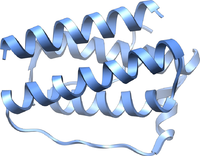
Photo from wikipedia
Background The interleukin (IL)−23/IL-17A immune pathway is critical for the development of autoimmune arthritis. Moreover, systemic exposure of IL-23 induced chronic arthritis, increased osteoclast differentiation and systemic bone loss in… Click to show full abstract
Background The interleukin (IL)−23/IL-17A immune pathway is critical for the development of autoimmune arthritis. Moreover, systemic exposure of IL-23 induced chronic arthritis, increased osteoclast differentiation and systemic bone loss in mice. However, the role of IL-23 on normal and pathologic bone remodelling is not fully elucidated. We studied the role of IL-23R signalling on normal bone phenotype and bone damage during a T cell-mediated inflammatory arthritis in vivo and osteoclast differentiation and activity in vitro. Materials and methods For antigen-induced arthritis (AIA), WT and IL-23RGFP+/GFP+ (IL-23R/-) mice were immunised with methylated bovine serum albumin (mBSA) in supplemented Complete Freund’s Adjuvant. After 7 days mice were injected in the knee joints with mBSA. Mice were macroscopically scored at given time points and knees were used for histological analysis. Naïve WT and IL-23R/- bone marrow cells (BM) were cultured towards osteoclasts with MCSF, RANKL and +/- IL-23 and assessed for tartrate-resistant acid phosphatase (TRAP) staining, qPCRs and bone resorption. Femurs were used for MicroCT analysis and three-point bending test. Results During AIA the onset of disease was not prevented in IL-23R-/- mice. However, the progression of arthritis was diminished, resulting in significantly less disease. Histological analysis revealed significantly less inflammation-mediated bone damage in knees of IL-23R/- versus WT mice. In vitro, IL-23 had no direct effect on the number of TRAP+ cells, but increased bone resorption by osteoclasts. Interestingly, microCT data revealed a low bone mass phenotype in IL-23R-/- mice, with lower trabecular bone volume fraction, thickness and number as well as lower cortical volume and thickness. Preliminary three-point bending data show significantly reduced maximum force in IL-23RKO femurs. Conclusions In vitro, IL-23 is involved in the activation of osteoclasts. Whereas T cell-driven inflammatory bone erosion is IL-23R signalling mediated, during normal bone remodelling IL-23R signalling is important for the maintenance of bone mass.
Journal Title: Annals of the Rheumatic Diseases
Year Published: 2017
Link to full text (if available)
Share on Social Media: Sign Up to like & get
recommendations!